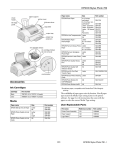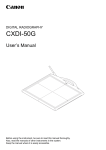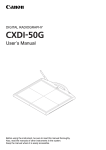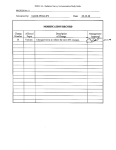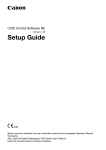Download Canon CXDI-55G User's Manual
Transcript
Digital Radiography CXDI-55G User’s Manual Before using the instrument, be sure to read this manual thoroughly. Also, read the manuals of other instruments in the system. Keep the manual where it is easily accessible. PLEASE NOTE 1. The user is responsible for the use and maintenance of the product. We suggest that a member of the user’s staff be designated as being in charge of maintenance so as to ensure that the product is kept in a safe and good condition. Also, medical products must be used only by a qualified person. 2. Roentgenography, image processing, reading of image, and storage of data must be performed in accordance with the law of the country where the product is being used. Also, the user is responsible for maintaining the privacy of image data. 3. In no event will Canon be liable for direct or indirect consequential damage arising out of the use of this product. Canon will not be liable for loss of image data due to any reason. 4. This product may malfunction due to electromagnetic waves caused by portable personal telephones, transceivers, radio-controlled toys, etc. Be sure to avoid having objects such as these, which affect this product, brought near the product. 5. Disposal of this product in an unlawful manner may have a negative impact on health and on the environment. When disposing of this product, therefore, be absolutely sure to follow the procedure which is in conformity with the laws and regulations applicable in your area. 6. Canon reserves the right to change the specifications, configuration and appearance of the product without prior notice. European Union (and EEA*) only. This symbol indicates that this product is not to be disposed of with your household waste, according to the WEEE Directive (2002/96/EC) and your national law. This product should be handed over to a designated collection point, e.g., on an authorized one-for-one basis when you buy a new similar product or to an authorized collection site for recycling waste electrical and electronic equipment (EEE). Improper handling of this type of waste could have a possible negative impact on the environment and human health due to potentially hazardous substances that are generally associated with EEE. At the same time, your cooperation in the correct disposal of this product will contribute to the effective usage of natural resources. For more information about where you can drop off your waste equipment for recycling, please contact your local city office, waste authority, approved WEEE scheme or your household waste disposal service. For more information regarding return and recycling of WEEE products, please visit www.canon-europe.com. * EEA : Norway, Iceland and Liechtenstein • System and product names in this manual are the trademarks of each manufacturer that developed them. © CANON INC. 2009 All rights reserved. Under copyright laws, this manual may not be copied, in whole or in part, without the written consent of Canon. Safety Information Regulations This instrument conforms to IEC 60601-1-2:2001. For U.S.A. and Canada • This instrument is a CLASS I EQUIPMENT according to UL60601-1 and CAN/CSA C22.2 No.601.1. • The following mark indicates that the instrument is a Type B Applied Parts. • The degree of protection against ingress of water is IPX0. • This equipment is not suitable for use in the presence of a flammable anaesthetic mixture with air or with oxygen or nitrous oxide. • The mode of operation is Continuous Operation. For EU Countries • The following mark shows compliance of the instrument with Directive 93/42/EEC. • This instrument has been classified into EN55011 Group 1/Class A. • This instrument is a CLASS I EQUIPMENT according to EN 60601-1. • The following mark indicates that the instrument is a Type B Applied Parts. • The degree of protection against ingress of water is IPX0. • This equipment is not suitable for use in the presence of a flammable anaesthetic mixture with air or with oxygen or nitrous oxide. • The mode of operation is Continuous Operation. (1) Safety Information Guidance and Manufacturer’s Declaration for EMC Directive Electromagnetic Emissions The CXDI-55G is intended for use in the electromagnetic environment specified below. The user of the CXDI-55G should assure that it is used in such an environment. Emission Test Compliance Electromagnetic Environment – Guidance RF emissions CISPR 11 GROUP 1 The CXDI-55G uses RF energy only for its internal function. Therefore, its RF emissions are very low and are not likely to cause any interference in nearby electromagnetic equipment. RF emissions CISPR 11 Class A Harmonic emissions IEC 61000-3-2 Complies The CXDI-55G is suitable for use in all establishments other than domestic and those directly connected to the public low-voltage power supply network that supplies buildings used for domestic purposes. Voltage fluctuations/ flicker emissions IEC 61000-3-3 Complies (2) Safety Information Electromagnetic Immunity The CXDI-55G is intended for use in the electromagnetic environment specified below. The user of the CXDI-55G should assure that it is used in such an environment. Immunity Test Electrostatic discharge (ESD) IEC 61000-4-2 Electrical fast transient/burst IEC 61000-4-4 Surge IEC 61000-4-5 Voltage dips, short interruptions and voltage variations on power supply input lines IEC 61000-4-11 Power frequency (50/60Hz) magnetic field IEC 61000-4-8 IEC 60601 Test Level Compliance Level ±(2, 4, 6) kV contact ±(2, 4, 6) kV contact ±(2, 4, 8) kV air ±(2, 4, 8) kV air ±2 kV for power supply lines ±2 kV for power supply lines ±1 kV for input/output lines ±1 kV for input/output lines ±1 kV differential mode ±1 kV differential mode ±2 kV common mode ±2 kV common mode <5% UT (>95% dip in UT) for 0.5 cycle. <5% UT (>95% dip in UT) for 0.5 cycle. 40% UT (60% dip in UT) for 5 cycles 40% UT (60% dip in UT) for 5 cycles 70% UT (30% dip in UT) for 25 cycles 70% UT (30% dip in UT) for 25 cycles <5% UT (>95% dip in UT) for 5 sec. <5% UT (>95% dip in UT) for 5 sec. 3 A/m 3 A/m Electromagnetic Environment – Guidance Floors should be wood, concrete or ceramic tile. If floors are covered with synthetic material, the relative humidity should be at least 30%. Mains power quality should be that of a typical commercial or hospital environment. Mains power quality should be that of a typical commercial or hospital environment. Mains power quality should be that of a typical commercial or hospital environment. If the user of the CXDI-55G requires continued operation during power mains interruptions, it is recommended that the CXDI-55G be powered from an uninterruptible power supply or a battery. Power frequency magnetic fields should be at levels characteristic of a typical location in a typical commercial or hospital environment. NOTE: UT is the a.c. mains voltage prior to application of the test level. (3) Safety Information Immunity Test IEC 60601 Test Level Compliance Level Conducted RF IEC 61000-4-6 3 Vrms 150 kHz to 80 MHz 3Vrms Radiated RF IEC 61000-4-3 3 V/m 80 MHz to 2.5 GHz 3 V/m Electromagnetic Environment – Guidance Portable and mobile RF communications equipment should be used no closer to any part of the CXDI-55G, including cables, than the recommended separation distance calculated from the equation applicable to the frequency of the transmitter. Recommended separations distance d = 1.2 P d = 1.2 P 80 MHz to 800 MHz d = 2.3 P 800MHz to 2.5 GHz where P is the maximum output power rating of the transmitter in watts (W) according to the transmitter manufacturer and d is the recommended separation distance in metres (m). Field strengths from fixed RF transmitters, as determined by an electromagnetic site surveya, should be less than the compliance level in each frequency rangeb. Interference may occur in the vicinity of equipment marked with the following symbol: NOTE 1: At 80 MHz and 800 MHz, the higher frequency range applies. NOTE 2: These guidelines may not apply in all situations. Electromagnetic propagation is affected by absorption and reflections from structures, object and people. a Field strengths from fixed transmitters, such as base stations for radio (cellular/cordless) telephones and land mobile radios, amateur radio, AM and FM radio broadcast and TV broadcast cannot be predicted theoretically with accuracy. To assess the electromagnetic environment due to fixed RF transmitters, an electromagnetic site survey should be considered. If the measured field strength in the location in which the CXDI-55G is used exceeds the applicable RF compliance level above, the CXDI-55G should be observed to verify normal operation. If abnormal performance is observed, additional measures may be necessary, such as reorienting or relocating the CXDI-55G. b Over the frequency range 150 kHz to 80 MHz, field strengths should be less than 3 V/m. (4) Safety Information Recommended Separation Distances The CXDI-55G is intended for use in an electromagnetic environment in which radiated RF disturbances are controlled. The user of the CXDI-55G can help prevent electromagnetic interference by maintaining a minimum distance between portable and mobile RF communications equipment (transmitters) and the CXDI-55G as recommended below, according to the maximum output power of the communications equipment. Rated maximum output power of transmitter Separation distance according to frequency of transmitter m 150 kHz ~ 80 MHz 80 MHz ~ 800 MHz 800 MHz ~ 2.5 GHz W d = 1 .2 P d = 1 .2 P d = 2 .3 P 0.01 0.12 0.12 0.23 0.1 0.38 0.38 0.73 1 1.2 1.2 2.3 10 3.8 3.8 7.3 100 12 12 23 For transmitters rated at a maximum output power not listed above, the recommended separation distance d in metres (m) can be estimated using the equation applicable to the frequency of the transmitter, where P is the maximum output power rating of the transmitter in watts (W) according to the transmitter manufacturer. NOTE 1: At 80 MHz and 800 MHz, the separation distance for the higher frequency range applies. NOTE 2: These guidelines may not apply in all situations. Electromagnetic propagation is affected by absorption and reflection from structures, objects and people. NOTE 1: To maintain the optimum EMC performance, use only the cables which are designated. Name Type of shield Length Notes Power cable Non-shielded 3m Provided with Power Box Sensor cable Shielded 7.8 m Provided with the Sensor Unit X-ray interface cable Non-shielded 20 m Provided with Power Box Remote switch cable Non-shielded 20 m Provided with Power Box LAN cable Non-shielded Max. 20 m Not provided NOTE 2: Do not install the CXDI-55G and Power Box (CXDI SYSTEM II) adjacent to or stacked on top of or underneath any other system devices. NOTE 3: Essential Performance in terms of Electromagnetic Disturbances • No adverse effects on image acquisition • No adverse effects on image data transmission (5) Safety Information General Safety Information Follow the safety instructions in this manual and all warnings and cautions printed on the warning labels. Ignoring such cautions or warnings while handling the product may result in injury or accident. Be sure to read and fully understand the manual before use. Keep this manual for future reference. Meaning of Caution Signs ! WARNING This indicates a potentially hazardous situation which, if not heeded, could result in death or serious injury to you or others. ! CAUTION This indicates hazardous situation which, if not heeded, may result in minor or moderate injury to you or others, or may result in machine damage. NOTE This is used to emphasize essential information. Be sure to read this information to avoid incorrect operation. Installation and Environment of Use ! WARNING Do not use or store the instrument near any flammable chemicals such as alcohol, thinner, benzine, etc. Also, this instrument is not a category AP or APG equipment. If chemicals are spilled or evaporate, it may result in fire or electric shock through contact with electric parts inside the instruments. Also, some disinfectants are flammable. Be sure to take care when using them. ! CAUTION Do not install the instrument in a location with the conditions listed below. Otherwise, it may result in failure or malfunction, fall or cause fire or injury. • Close to facilities where water is used. • Where it will be exposed to direct sunlight. • Close to air-conditioner or ventilation equipment. • Close to heat source such as a heater. • Prone to vibration. • Insecure place. • Dusty environment. • Saline or sulfurous environment. • High temperature or humidity. • Freezing or condensation. Installation Operation ! WARNING Do not connect the instrument with anything other than specified. Otherwise, it may result in fire or electric shock. (6) Safety Information Power Supply ! WARNING Be sure to turn OFF the power of each instrument before connecting or disconnecting the cables. Also, do not handle them with wet hands. Otherwise, you may get an electric shock that may result in death or serious injury. ! WARNING Be sure to hold the plug or connector to disconnect the cable. If you pull the cable, the core wire may be damaged, resulting in fire or electric shock. ! WARNING Do not cut or process the cables. Also, do not place anything heavy, including the instrument on it, step on it, pull it, bend it, or bundle it. Otherwise, the cable may be damaged, which may result in fire or electric shock. ! WARNING Do not turn ON the system power when condensation is formed on the instrument. Otherwise, it may result in fire or electric shock. ! CAUTION Because the instrument’s cable is long, take care so cables do not get tangled during use. Also, be careful not to get your feet caught in the cable. Handling ! WARNING Always be sure to keep checking the condition of the system and the patient to ensure they are normal during the use of the instrument. If any problem is found, take appropriate measures, such as stopping the operation of the instrument, as required. ! WARNING Never disassemble or modify the product as it may result in fire or electric shock. Also, since the instrument incorporates parts that may cause electric shocks and other hazardous parts, touching them may cause death or serious injury. ! WARNING Do not hit or drop the instrument. The instrument may be damaged if it receives a strong jolt, which may result in fire or electric shock if the instrument is used without it being repaired. ! CAUTION Do not spill liquid or chemicals onto the instrument or, in cases where the patient is injured, allow it to become wet with blood or other body fluids, as doing so may result in fire or electric shock. In such situation, protect the instrument with disposable covering as necessary. ! CAUTION Wipe the CFRP plate of the sensor unit with ethanol or glutaraldehyde solution to disinfect it each time a different patient uses the instrument, in order to prevent infection. If the optional grid unit is being used, disinfect its surface. Please consult a specialist for the procedure for disinfection. ! CAUTION Turn off the power of each instrument for safety when they are not going to be used. (7) Safety Information When Problem Occurs ! WARNING Should any of the following occur, immediately turn OFF the power of each instrument, unplug the power cable from the AC outlet, and contact Canon representative or distributor. • When there is smoke, odd smell or abnormal sound. • When liquid has been spilled into the instrument or a metal object has entered through an opening. • When the instrument has been dropped and it is damaged. Maintenance and Inspection ! WARNING For safety reasons, be sure to turn OFF the power of each instrument when the inspections indicated in this manual are going to be performed. Otherwise, it may result in electric shock. ! WARNING When the instrument is going to be cleaned, be sure to turn OFF the power of each instrument, and unplug the power cable from the AC outlet. Never use alcohol, benzine, thinner or any other flammable cleaning agents. Otherwise, fire or electric shock may result. ! WARNING The instrument must be repaired by a qualified engineer only. If it is not repaired properly, it may cause fire, electric shock, or accident. ! CAUTION For safety reasons, be sure to inspect the instrument before using it. In addition, carry out a regular inspection at least once a year. (8) Safety Information Labels and Markings on the Instrument The CXDI-55G has a few labels and markings on it. Contents of those and positions where they are attached are indicated below. Sensor Unit Front This mark indicates that this is a Type B Applied Part according to UL60601-1 and EN60601-1. This unit can be installed in the patient environment. These marks indicate that the instrument must be handled with care. Do not jolt or apply excessive load to the instrument. Rear Name Label (9) Contents Safety Information .................................................................................................... (1) Regulations ................................................................................................................................(1) Guidance and Manufacturer’s Declaration for EMC Directive ................................................... (2) General Safety Information ........................................................................................................ (6) Labels and Markings on the Instrument .....................................................................................(9) 1. Overview .................................................................................................................1 2. Notes for Using the Instrument ...............................................................................2 3. Description ..............................................................................................................5 4. Operation ................................................................................................................6 4.1 Turning ON/OFF the Power of the System ........................................................................... 6 4.2 Calibration ............................................................................................................................. 6 4.3 Connecting and Disconnecting the Sensor Cable Relay Connector .................................... 6 5. Inspection and Maintenance ...................................................................................8 5.1 Inspection ............................................................................................................................. 8 5.2 Cleaning .............................................................................................................................. 11 6. Service Information ...............................................................................................12 7. Specifications .......................................................................................................13 7.1 Main Specifications ............................................................................................................. 13 7.2 Characteristics .................................................................................................................... 14 8. Components ..........................................................................................................16 9. Dimensions ...........................................................................................................17 Appendix: Attaching the Optional Grid Unit ...............................................................18 1. Overview The Canon Digital Radiography CXDI-55G is a portable digital radiography that can take images of any part of the body. It directly converts the X-ray images captured by the LANMIT (Large Area New MIS Sensor and TFT) sensor into a high-resolution digital images. The instrument is suited for use inside a patient environment. –1– 2. Notes for Using the Instrument (1) Handling Handle the instrument carefully, as it may be damaged if something is hit against it, dropped, or receives a strong jolt. Also, handle the optional grid unit with care too. Do not pull the cable. Also, do not pull the sensor unit when the cable is tangled with something. Otherwise, the cable may be damaged, which may result in fire or electric shock. When transporting the instrument, do not allow the sensor cable relay connector to drag on the floor or ground or bump against anybody or any articles of property. It is recommended to hold the cable while transporting the instrument. Otherwise, the connector get caught by, bump against somebody resulting in injury or cause damage to the property items and/or connector itself as a result. (2) Before Exposure Sudden heating of the room in cold areas will cause condensation to form on the instrument. In this case, wait until condensation disappears before performing exposure. If the instrument is used with condensation formed on it, problems may occur in the quality of the instrument. When an air-conditioner is going to be used, be sure to raise/lower the temperature gradually so that a difference in temperature in the room and in the instrument does not occur, to prevent forming of condensation. –2– 2. Notes for Using the Instrument (3) During Exposure Do not apply excessive weight to the sensor unit. Otherwise, the sensor may be damaged. Limit of Load Uniform load: 150 kg over the whole area of sensor unit surface. Local load: 100 kg on an area 40 mm in diameter. Be sure to use the sensor unit on a flat place so it will not bend. Otherwise, the sensor may be damaged. Perform exposure after checking that the exposure conditions are optimally suited to this product. The sensitivity of the sensor differs depending on the product. This is also different from the CXDI-55C. –3– 2. Notes for Using the Instrument (4) During Cleaning Do not use anything other than neutral detergent for cleaning the cover of the instrument. Otherwise, the coating will be corroded. (5) Storage Be sure to store the sensor unit and the optional grid unit in a safe place where it will not fall or drop. (6) Others Be sure to reconnect the cables to the proper connectors. Otherwise, the instrument may malfunction or may be damaged. For U.S.A. Rx only-Caution: Federal law restricts this device to sale by or on the order of a licensed practitioner. Intended Use: Canon digital radiography CXDI-55G provides digital image capture for conventional film/screen radiographic examinations. The device is intended to replace radiographic film/screen systems in all general purpose diagnostic procedures. This device is not intended for mammography applications. For European Union Intended Use: This device provides digital X-Ray image for diagnosis of disease, injury, or any applicable health problem. The image is obtained as the result of imaging X-ray passed through human body with the X-ray flat panel detector and importing digital signals output from the detector into the image processor. –4– 3. Description Sensor Unit This unit converts the X-rays into digital signals. a d b e c f g Name Description a Grip Hold this grip when carrying the sensor unit. b CFRP (Carbon Fiber Reinforced Plastic) plate The part of the patient’s body to which an image is to be taken should be placed against this plate. This plate should be disinfected each time a different patient uses the instrument in order to prevent infection. c Sensor cable Connect this cable to the power box (sold separately) through the relay connector. d BUSY lamp Lights when the sensor unit is busy communicating. e SENSOR lamp Blinks while the instrument is being readied for exposures and when errors have occurred. Lights when the instrument is ready for exposures. f POWER lamp Lights when the power of sensor unit is ON. g Effective capture area border Indicates the effective capture area. –5– 4. Operation 4.1 Turning ON/OFF the Power of the System When turning ON/OFF the power of the sensor unit, refer to the Power Box (sold separately) Operation Manual. 4.2 Calibration Calibration is important to ensure that a good image is achieved with the CXDI-55G by obtaining the calibration data of the sensor unit. Perform calibration when exposure conditions have changed significantly. NOTE: For procedure for calibrating, refer to “Calibrating the Instrument” in the CXDI Series Operation Manual. 4.3 Connecting and Disconnecting the Sensor Cable Relay Connector Follow the steps below to connect or disconnect the sensor cable relay connector. NOTE: Do not connect this sensor unit to the power box other than CXDI SYSTEM II. It may cause damage to the connector. In addition, it is necessary to register each sensor unit to the software for controlling the system. For details on registering the sensor unit, contact Canon representative or distributor. NOTE: When connecting or disconnecting the sensor cable relay connector, refer to the CXDI Series Operation Manual, set the power switch on the power box (or remote switch) to OFF and check that the POWER lamps on the sensor unit, power box and remote switch are off. The ERROR lamp will light if the connector is connected or disconnected while the POWER lamp is lighted. NOTE: Be absolutely sure to hold the sensor cable relay connector by its grip part to connect or disconnect it. Holding the cable to connect or disconnect the connector may break the wires inside the cable. If the outer bushing of the grip part is turned, the cable lock can be loosened, and this can cause a short-circuit of the cable. NOTE: Do not drop the sensor cable relay connector when connecting or disconnecting it. You may injure yourself or cause damage to the property or connector. –6– 4. Operation (1) (2) (3) Align the positioning marks. Align the positioning mark on the connector at the sensor unit side with the positioning mark on the connector at the power box side, and insert the connectors while turning them slightly to the left or right. Push the connectors in by one step. Push them in until they click into place. Push the connectors in by another step. Push them firmly in until they click into place again to lock them together. To disconnect the sensor cable relay connector: Hold the grip parts of the connectors on both sides, and pull the grip part on the sensor unit side to release the lock. Now pull the connectors to the left and right to disconnect. –7– Sensor unit side Positioning mark Grip part Power box side Locking latch Positioning mark Grip part 2 to 3 mm 5. Inspection and Maintenance ! WARNING The instrument must be repaired by a qualified engineer only. If it is not repaired properly, it may cause fire, electric shock, or accident. ! CAUTION For safety reasons, be sure to inspect the instrument before using it. In addition, carry out a regular inspection at least once a year. 5.1 Inspection In order to ensure that the instrument is used safely and normally, please be sure to inspect the instrument before use. If any problem is found during the inspection, please take measures indicated in this chapter. If problem still cannot be corrected, please contact Canon representative or distributor. It is recommended that a record of the inspection be kept by making copies of the check lists in this section, or making a separate check list. –8– 5. Inspection and Maintenance 5.1.1 Daily Inspection 5.1.1.1 Before Turning ON the Power ! WARNING For safety reasons, be sure to turn OFF the power of each instrument when the following inspections are going to be performed. Otherwise, it may result in electric shock. Result Sensor unit Cable Inspection Remedy Date / Date / Date / Check that cables are not damaged or cover of cables is not torn. Good/Bad Good/Bad Good/Bad Contact Canon or distributor if there is any problem. Check that the plugs and locks of connectors are not loose. Good/Bad Good/Bad Good/Bad Fully insert the cables and lock them. Check that there are no cracks in the holder (pull-out part) of the sensor cable. Good/Bad Good/Bad Good/Bad Contact Canon or distributor if there are any cracks in the holder. Check that the cover or parts are not damaged and not loose. Good/Bad Good/Bad Good/Bad Contact Canon or distributor if there is any problem. 5.1.1.2 After Turning ON the Power Result General Inspection Remedy Date / Date / Date / Check that POWER lamp is lit. Good/Bad Good/Bad Good/Bad Perform test exposure. Take measures if error message is displayed by referring to the CXDI Series Good/Bad Good/Bad Good/Bad Operation Manual. Contact Canon or distributor if the problem cannot be solved. –9– Connect the power cable and sensor cable properly. 5. Inspection and Maintenance 5.1.2 Monthly Inspection Perform the following inspection periodically more than once a month. Contact Canon representative or distributor if there is any problem or if you cannot do it. Result General Inspection Check the performance of the instrument by performing exposures using a phantom or a resolution chart, or perform self-test. Date / Date / Date / Remedy Refer to the CXDI Series Operation Manual for the Good/Bad Good/Bad Good/Bad procedure for self-test. Contact Canon or distributor if there is any problem. 5.1.3 Yearly Inspection Perform the following inspection periodically more than once a year. Contact Canon representative or distributor if there is any problem or if you cannot do it. Result General Inspection Check the performance of the instrument by performing exposures using a phantom or a resolution chart. Date / Date / Date / Good/Bad Good/Bad Good/Bad Remedy Contact Canon or distributor if there is any problem. 5.1.4 Calibration Perform calibration when exposure conditions have changed significantly. See the CXDI Series Operation Manual for the procedure for calibration. – 10 – 5. Inspection and Maintenance 5.2 Cleaning 5.2.1 CFRP (Carbon Fiber Reinforced Plastic) Plate of the Sensor Unit ! WARNING Wipe the CFRP plate of the sensor unit with ethanol or glutaraldehyde solution to disinfect it each time a different patient uses the instrument, in order to prevent infection. If the optional grid unit is being used, disinfect its surface. Please consult a specialist for the procedure for disinfection. If you are using disinfectant other than those specified above, or you are mixing another disinfectant with ethanol, please also consult a specialist, because they may harm the CFRP plate and grid unit. Disinfect the CFRP plate of the sensor unit each time a different patient uses the instrument. If the optional grid unit is being used, disinfect its surface. 5.2.2 Cover ! WARNING When the instrument is going to be cleaned, be sure to turn OFF the power of each instrument, and unplug the power cable from the AC outlet. Never use alcohol, benzine, thinner or any other flammable cleaning agents. Otherwise, fire or electric shock may result. Clean the cover by the following procedure if it is dirty. (1) Turn OFF the power of the power box. Shut down the control computer, and press side “0” of the power switch. (2) Turn OFF the power of each instrument. Turn OFF the power of each instrument if connected. (3) Unplug the power cables. Unplug the power cables of each instrument from the AC outlet. (4) Wipe the cover using neutral detergent. Wipe the cover with a piece of cloth soaked in neutral detergent diluted in water and wrung dry. (5) Wipe out neutral detergent. Wipe the cover with a piece of cloth soaked in water and wrung dry whenever neurtral detergent has been used. – 11 – 6. Service Information (1) Repair If problem cannot be solved even after taking the measures indicated in chapter 5, contact Canon representative or distributor for repair. Please refer to the name label and let us have the following information: Name of the unit: CXDI-55G Serial number: 6-digit number indicated on the name label. Phenomenon: In detail. (2) Limit for Supplying Performance Parts for Repair Performance parts* of this product will be stocked for eight years after discontinuance of production, to allow for repair. * Parts required to maintain the functioning of the product – 12 – 7. Specifications 7.1 Main Specifications Sensor Unit Purpose General radiography Pixel size 160 × 160 µm Image matrix size 2208 × 2688 pixels Number of pixels Approx. 5.9 million pixels Dynamic range Approx. 80 dB Resolution 3.1 lp/mm Gray scale 12-bit, 4,096 gray scale Environmental requirements Operation: Temperature: +5 to +35 °C Humidity: 30 to 75 %RH (no condensation) Storage and transportation: Temperature: -30 to +50 °C Humidity: 10 to 60 %RH (no condensation) Atmospheric pressure: 700 to 1060 hPa Power Supplied from the power box. Dimensions and mass 480 (W) × 481 (H) × 15 (D) mm, 3.4 kg (excluding the sensor cable) – 13 – 7. Specifications 7.2 Characteristics (1) Required patient doses Equivalent to exposure dose of 200 or 400 speed film/screen system. (2) Sensitometric characteristics 100000 saturation Output(LSB) 10000 1000 100 10 RQA5(70kVp+21mmAl) 1 0.01 0.1 1 10 100 1000 Image receptor air kerma(uGy) (3) Presampled MTF 1 Presampling MTF 0.8 0.6 0.4 0.2 0 0 1 2 3 Spatial frequency(lp/mm) – 14 – 4 5 7. Specifications (4) DQE 1 DQE 0.05mR 0.5mR 5mR 0.1 0.01 0 0.5 1 1.5 2 Spatial frequency(lp/mm) – 15 – 2.5 3 8. Components Sensor unit (Sensor cable S150-55 provided) ...........................................1 Sensor cable P630......................................................................................1 System Equipment (sold separately) Digital Radiography Power Box (CXDI SYSTEM II) (with Remote switch) Grid unit for CXDI-55 Sensor cable P630-PM: Secures the relay connector on the power box side to a stand etc. SP780-55: Connects directly to the sensor unit and power box without using a relay connector. – 16 – 9. Dimensions 481 Sensor Unit 480 15 Unit: mm – 17 – Appendix: Attaching the Optional Grid Unit Attach the optional grid unit to the sensor unit by the procedure indicated below. NOTE: Structure of grid unit is delicate. Do not drop, knock over, bend, or apply force or jolt to it. Otherwise, the unit may be damaged. When the grid unit is not in use, remove it from the sensor unit and store it in a safe place where it will not fall. Even if it is not extremely damaged, its characteristics may be changed, which may cause a problem in image quality. (1) Blow off the dust on the front and back of the grid unit. (2) Place the sensor unit horizontally on a table. (3) Hold the grid unit with both hands and engage the hooks on the bottom of the grid unit to the holes on the bottom of the sensor unit. Hook (4) Gently set the grid unit over the sensor unit. A click sound is heard when the grid unit is locked properly. NOTE: Ensure that the grid unit is locked before lifting the sensor unit. Otherwise, the grid unit will fall and be damaged. To remove the grid unit Lift up the grid unit top by about 50 mm while pressing the lock of the grid unit top in the direction of the arrow. Now remove the grid unit by sliding it downward. – 18 – Lock CANON INC. Medical Equipment Group 30-2, Shimomaruko 3-chome, Ohta-ku, Tokyo, Japan Telephone: (81)-3-3758-2111 CANON U.S.A., INC. CANON MEDICAL SYSTEMS 15955 Alton Parkway, Irvine, CA 92618-3616, U.S.A. Telephone: (1)-949-753-4160 CANON EUROPA N.V. Medical Products Division Bovenkerkerweg 59-61, 1185 XB Amstelveen, The Netherlands Telephone: (31)-20-545-8926 PUB. L-IE-4152 0609P0.001 Printed in Japan





































